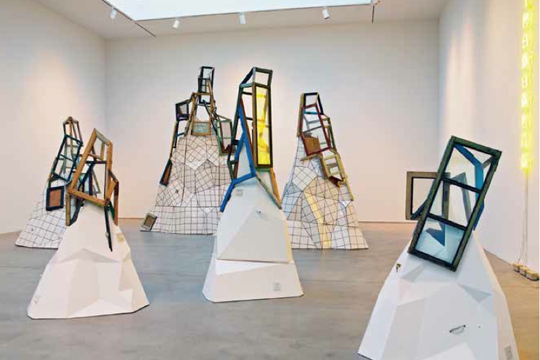SONG DONG: DOING NOTHING
| June 5, 2013 | Post In LEAP 20

Showcasing Song Dong’s work from the mid-1990s to the present, “Doing Nothing” occupies two out of three of Pace’s 25th Street galleries. Pace’s larger space, 534 W 25th, surveys Song’s performance-based work from 1994-2012 through video, sculpture, photography, and installation, while the smaller space at 510 W 25th St presents new, mostly sculptural works expanding on past projects utilizing building detritus the artist culled from the Beijing housing boom. Wildly heterogeneous in medium, affect and potency, works in these two surveys unite two-fold: they all ponder, as the title suggests, what it means to “do nothing,” or to wax upon the poetic as well as political and social ramifications of human activity, while also evincing Song’s position as an integral leader in bridging Western conceptual art practices with traditional Chinese artistic practices.
The survey of performance-based works at 534 W 25th bears little curatorial purview beyond relating to sales— if works were available, it seems, they were shown. Video works, most akin to performance in their time-based nature and thus increasingly autonomous as individual works, retain the artist’s intentionality and vigor far more than their photographic or sculptural counterparts. A wall of five videos on monitor, including works such as Broken Mirror (1999), Burning Mirror (2001), Catching Moonbeams on Water (2001), and Floating (2004), all play with various screens, lenses, or windows broken, burned or otherwise visually disrupted. These investigations into the function of the camera lens recall Western conceptual and video art masters such as Joan Jonas or Dan Graham circa the early 1970s, though Song pairs these conceits with those endemic to contemporary China. For instance, we see quotidian Beijing street scenes— oftentimes morning commuters on their way to work— only for the picture plane to be disturbed, inviting commentaries on observation and surveillance.
Less convincing are Song’s object-based works charged with the task of documenting his early performances. For Breathing (1996), the artist lay prone on Tiananmen Square for 40 minutes until a thin layer of ice developed on the pavement under his mouth. It is possible for viewers to understand this as a metaphor for “breathing life” into a site imbued with death and political turmoil; though this gesture is unique in its poeticism, the performance is positioned as two gargantuan diptych light boxes selling for well over USD 100,000.
In addition to a series about the vagaries of Chinese-to-English translation and a stop-motion animation documenting the artist’s dOCUMENTA (13) trash-heap-turned-hillock project, we find Song Dong’s new, disappointingly polite “Doing Nothing Mountains” sculptures at 510 W 25th. While the project, like past efforts at the Kiev Biennial (2012), Venice Biennale (2011) or his MoMA atrium (2009), purports to celebrate the “intelligence of the poor” by repurposing refuse leftover from construction sites, the “Doing Nothing Mountains” at Pace are so well-produced they fail to reference any of the strife they reference.
Silkscreened on Pace’s oversized lobby wall is a text by Pace Beijing president Leng Lin, who considers Chinese avant-garde artist Huang Yong Ping’s self-explanatory 1987 work A History of Chinese Painting and A Concise History of Modern Painting Washed in a Washing Machine for Two Minutes in the context of Song. Leng writes, “In the end, the pulp resulting from this process was exhibited, whereby ‘West’ and ‘East’ were de-civilized and irrevocably mixed together.” While there is something precious about this exhibition— Song clearly represents a thorough, earnest study of both Western and Chinese art history— there is something lacking by way of the artist’s adherence to both, and his hesitance to develop his own idiosyncratic visual vocabulary.

